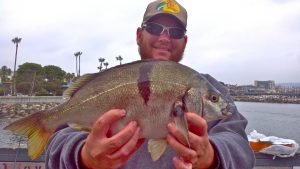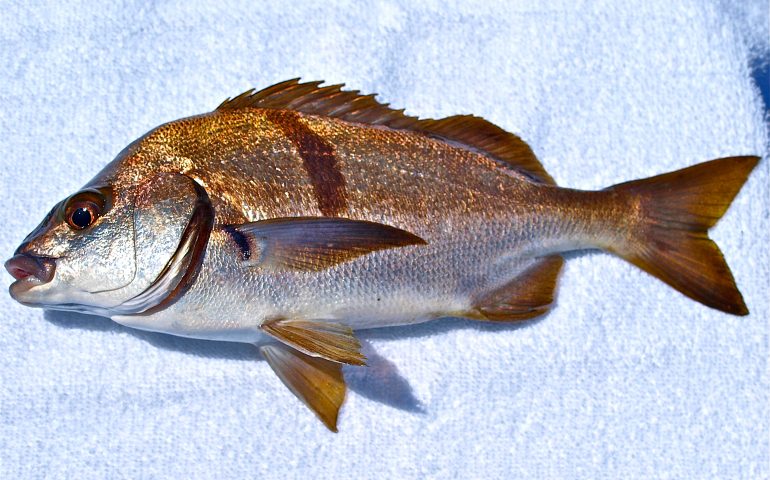Grunts: Family Haemulidae
Species: Anisotremus davidsonii (Steindachner, 1876); from the Greek word anisotremus (unequal aperture, in reference to the pores on the chin), and davidsonii (for George Davidson, a 19th Century astronomer at the California Academy of Sciences).
Alternate Names: China croaker, black croaker, blue bass, grunt, perch, sargo raiado. Called burro piedrero or sargo rayado in Mexico.
Identification: General perch shape but heavy bodied. The dorsal fin is long and ddeeply notched with spines longer than rays. They have 9 to 11 soft rays in the anal fin (perch have at least 13), and the second anal fin is strong and as long as the soft anal rays (anal fin spines of perch are weak and only half as long as the rays). Their coloring is entirely metallic silvery; iridescent with a grayish tinge above, plain silver below. A dark vertical bar runs across the body in the pectoral area. The shape and similar dark bar can, at times, lead to confusion with pileperch but sargo have a shorter anal fin and a different shape to the dorsal fin. In addition the bar is farther back on the perch and the tail of the perch is very forked. Sargo caught in bays tend to be darker in color. Both “golden” and “albino” sargo have been recorded in California.
Size: Supposedly to 23.6 inches and just over 3 1/2 pounds (but see below); most caught off piers are under 14 inches in length . The California angling record fish weighed 3 Lbs 3 oz and was taken at Catalina Island in 2010. The diving record fish weighed 3 Lbs 8 oz and was taken at Long Beach in 2019. The IGFA World Record fish weighed 4 Lbs. 0 oz. and was taken in Newport Beach Harbor in 2012.
Range: Chiapas, Mexico, Gulf of California (isolated population), and along the Pacific coast from southern Baja California, Todos Santos and Bahia Magdalena, north to Santa Cruz, California. Sargo are common from southern Baja California to about Santa Monica Bay, rare north of Point Conception.
Habitat: Primarily found inshore and in bays around rocky areas. Depth from the surf zone down to a recorded 201 feet.
Piers: Common at both oceanfront and bay piers north to Gaviota. Best bets: Embarcadero Marina Park Pier, Shelter Island Pier, Oceanside Pier, Oceanside Harbor Pier, Dana Harbor Pier, Seal Beach Pier, Belmont Veterans Memorial Pier, Long Beach Finger Piers, Cabrillo Pier, Redondo Harbor Sportfishing Pier, and the Santa Monica Pier.
Shoreline: A common catch by southern California shore anglers especially when fishing near rocky areas. Favored areas include Mission Bay and San Pedro Bay.
Boats: An inshore species rarely taken by boaters unless they are fishing in bays—San Diego Bay, Mission Bay, and San Pedro Bay.

Bait and Tackle: Sargo are bottom feeders that prefer ghost shrimp, fresh mussels, and worms, but they can be caught on almost any bait. Use size 8 to 4 hooks and fish on the bottom or a couple of feet above the bottom. The most commonly used rigging is a high/low leader.
Food Value: Good mild flavored meat with a firm texture. Can be cooked in almost any manner but perhaps best fried, baked or broiled.
Comments: A good sport fish, very similar to the larger croakers. The first sargo you catch may surprise you when you hold it and feel it grunt—not surprising since it belongs to the grunt family.

What’s the daily bag limit for Sargo?
10